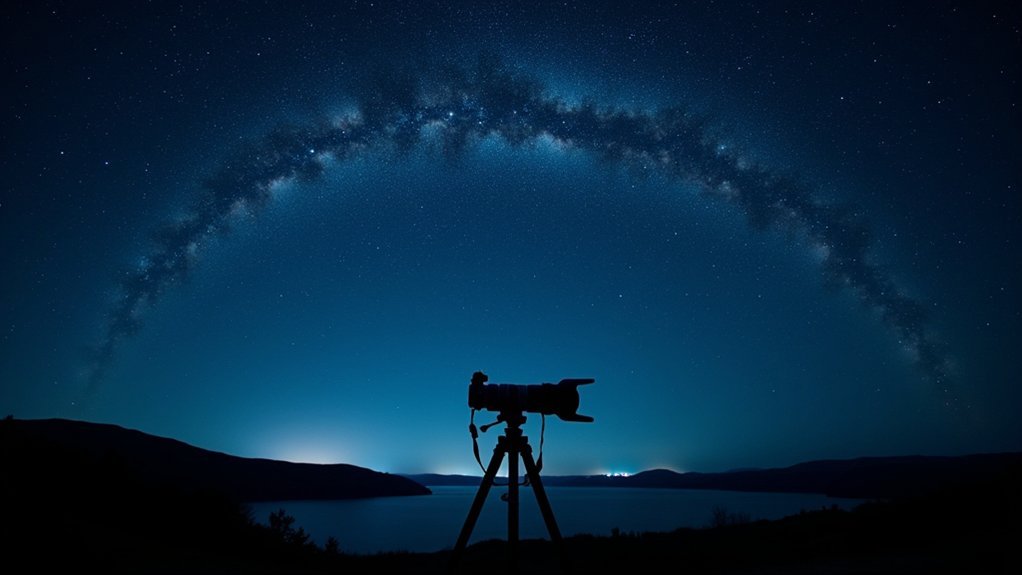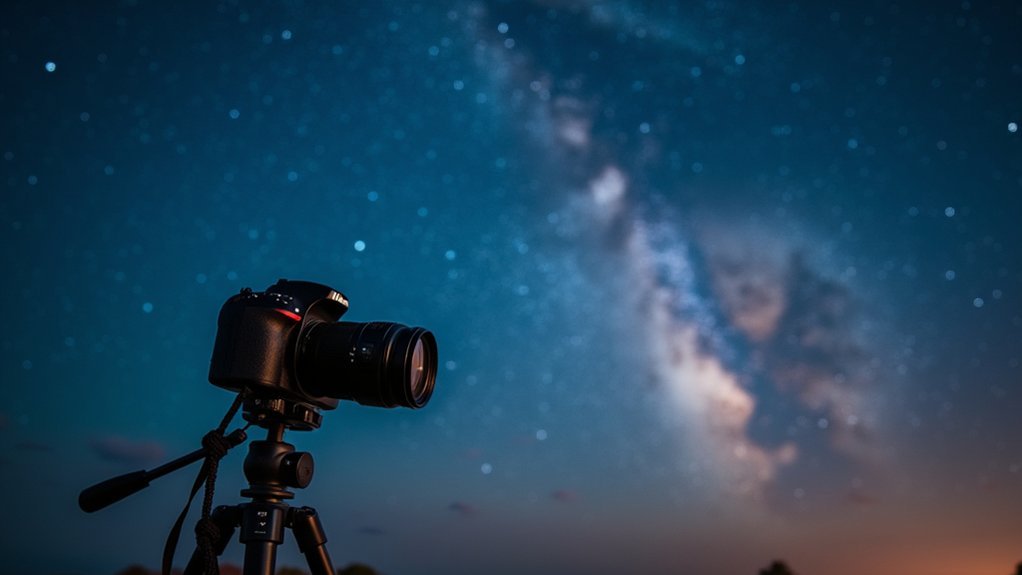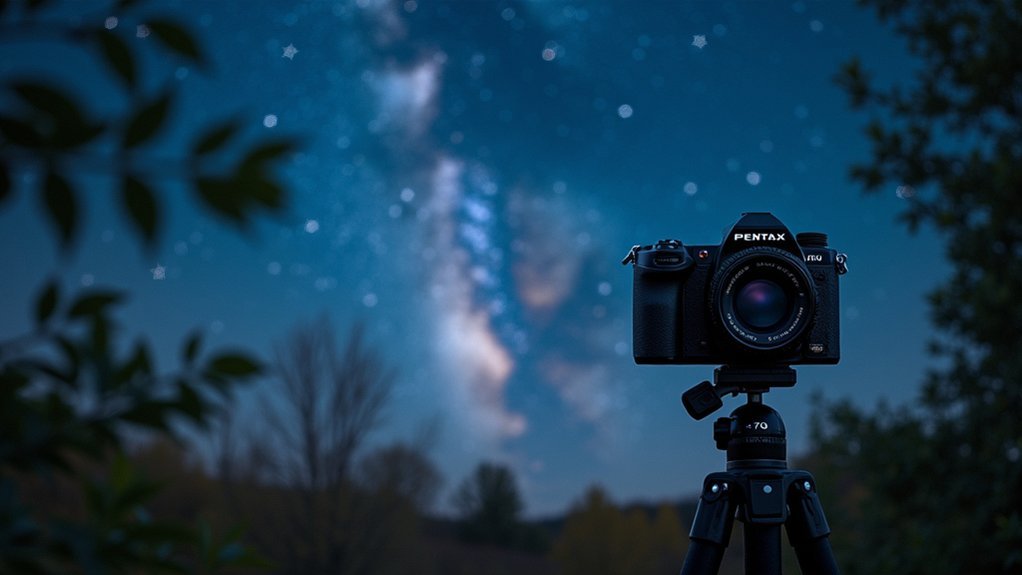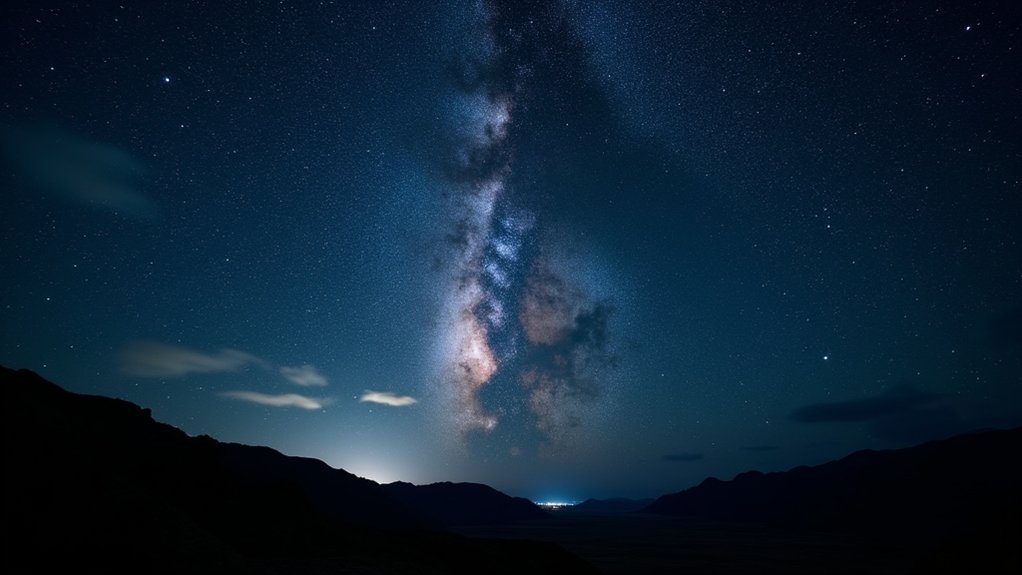For night sky photography, you’ll want to evaluate these beginner-friendly cameras: Canon EOS Rebel T7/T7i with strong low-light capabilities, Nikon D5600 with its excellent 24.2MP sensor, lightweight Sony A6000 featuring precise autofocus, Fujifilm X-T30 with impressive noise reduction, Pentax K-70 with its unique Astrotracer function, and Canon EOS 80D for more advanced features. Each offers specific advantages for capturing stunning celestial images. Explore these options to discover which aligns with your astrophotography goals.
7 Best Beginner Cameras for Night Sky Photography

Five excellent cameras stand out for beginners venturing into night sky photography. The Canon EOS Rebel T7 offers impressive 24.1MP resolution and strong low-light capabilities at a budget-friendly price.
Night photography beginners have excellent options with cameras like the Canon EOS Rebel T7 offering high resolution and impressive low-light performance.
If you’re seeking flexibility, the Nikon D5300 delivers with its 24.2MP sensor, built-in Wi-Fi, and convenient vari-angle LCD screen for creative compositions.
For something lighter, consider the mirrorless Canon EOS R8, weighing just 0.91 lbs while handling high ISO levels effectively—perfect for portable stargazing sessions.
The Nikon D7500 excels with its 20.9MP sensor and remarkable ISO range up to 51,200, ideal for capturing celestial details.
Many of these best DSLR cameras feature tilt-LCD displays, making it easier to frame your night sky shots without straining your neck during those long exposure sessions.
Canon EOS Rebel T7I: Affordable DSLR With Excellent Low-Light Performance
The Canon EOS Rebel T7i’s impressive ISO range of up to 25,600 (expandable to 51,200) will let you capture clear, low-noise images of the night sky even in challenging lighting conditions.
You’ll find the camera’s intuitive controls easy to navigate, with dedicated buttons for common settings and a touch-screen interface that simplifies adjustments during your astrophotography sessions.
The straightforward menu system and guided display options make this DSLR particularly approachable if you’re just starting your journey into night sky photography.
Impressive ISO Range
Many beginner astrophotographers struggle with capturing clear night sky images, which is why Canon’s EOS Rebel T7i stands out with its remarkable ISO range of 100-25,600. This extensive range gives you the flexibility to shoot in various lighting conditions without compromising image quality.
When you’re photographing faint celestial objects, you’ll appreciate how the T7i balances sensitivity with noise control. Unlike entry-level cameras with limited ISO capabilities, this model delivers impressive low-light performance that reveals details in the darkest skies.
You can confidently push the ISO higher when capturing the Milky Way or distant nebulae, knowing the 24.2MP APS-C sensor handles noise effectively.
For under $1,000, you’re getting professional-grade ISO performance that transforms challenging night sky photography sessions into rewarding experiences.
Beginner-Friendly Controls
Steering through the intimidating world of astrophotography becomes remarkably simple with the Canon EOS Rebel T7i’s intuitive control layout.
This DSLR camera prioritizes user experience without compromising on technical capabilities needed for low light photography.
- The vari-angle touchscreen allows you to frame your night sky shots from creative angles without straining your neck during those long exposure sessions.
- Intuitive menu system makes adjusting ISO settings quick and painless when conditions change rapidly during twilight shifts.
- Beginner-friendly controls are logically arranged, helping you focus on composition rather than fumbling with buttons.
- Wi-Fi and NFC connectivity let you remotely control the camera and share your celestial captures instantly, perfect for those late-night shooting sessions when you don’t want to disturb your setup.
Nikon D5600: User-Friendly Features for First-Time Astrophotographers

Aspiring astrophotographers will find the Nikon D5600 an excellent entry point into night sky photography. This user-friendly Nikon D model packs a powerful 24.2MP APS-C sensor that excels in low-light conditions, perfect for capturing celestial wonders.
| Feature | Benefit | Night Photography Application |
|---|---|---|
| 24.2MP APS-C Sensor | Detailed images | Captures star details clearly |
| ISO 100-25,600 | Low-light flexibility | Bright stars without excessive noise |
| Vari-angle touchscreen | Comfortable composition | Easy framing when camera is angled skyward |
| Wi-Fi/Bluetooth | Remote shooting | Control camera without creating vibrations |
You’ll appreciate the guide mode that helps decipher complex settings while you learn. The intuitive interface makes managing astrophotography settings straightforward, allowing you to focus on capturing stunning night skies rather than struggling with controls.
Sony A6000: Compact Mirrorless Option With Fast Autofocus
You’ll appreciate the Sony A6000’s remarkably lightweight 12.1-ounce design when you’re hiking to remote locations for clear night sky views.
The camera’s 179-point phase-detection autofocus system gives you a distinct advantage when trying to lock focus on celestial objects compared to entry-level DSLRs.
This compact mirrorless option won’t weigh down your backpack but still delivers professional-quality 24.3MP images with impressive low-light performance.
Lightweight Travel-Ready Design
When venturing into remote locations for night sky photography, the Sony A6000 stands out as an exceptional travel companion. Weighing just 0.87 lbs (396g), this compact camera won’t weigh down your pack during hikes to find perfect shooting locations.
- The lightweight body paired with compatible E-mount lenses creates a versatile system that’s easy to carry for extended periods.
- Its small footprint fits comfortably in smaller camera bags, leaving room for other night sky photography essentials.
- Despite its compact size, the 24.3MP APS-C sensor delivers exceptional low-light performance for capturing celestial details.
- The practical design doesn’t sacrifice functionality, offering a wide ISO range (100-25,600) for flexibility in challenging lighting conditions.
You’ll appreciate this portable powerhouse when trekking to remote areas with minimal gear.
Autofocus Performance Advantage
The Sony A6000’s compact design isn’t its only standout feature – its autofocus system truly sets it apart for night sky photography.
With an impressive 179 phase-detection and 25 contrast-detection points, you’ll capture celestial objects with remarkable precision, even in challenging low-light conditions.
This advanced hybrid autofocus performance allows you to track moving elements like meteor showers at up to 11 frames per second. You won’t miss those fleeting moments that make night sky photography so rewarding.
The A6000’s APS-C sensor delivers exceptional low-light performance, producing minimal noise at higher ISO settings – essential when shooting the stars.
Combine this with RAW format capabilities, and you’ll have tremendous flexibility to enhance your astro images during post-processing, bringing out details that might otherwise remain hidden.
Canon EOS 80D: Advanced Features at a Mid-Range Price Point

Aspiring astrophotographers will find the Canon EOS 80D strikes an impressive balance between professional capabilities and accessibility.
This versatile DSLR camera excels in night photography with its 24.2 MP APS-C sensor that delivers excellent low-light performance and dynamic range.
- The expandable ISO range up to 25,600 lets you capture clear, low-noise images of the night sky.
- 45-point all cross-type autofocus system guarantees precise focusing on celestial objects.
- 3-inch vari-angle touchscreen simplifies composition from unusual angles when your camera is mounted on a tripod.
- Built-in Wi-Fi and NFC connectivity enables remote camera control—perfect for long exposures without introducing vibrations.
You’ll appreciate how these features combine to deliver professional-quality astrophotography results without requiring advanced technical expertise or breaking your budget.
Fujifilm X-T30: Superior ISO Performance for Clearer Star Images
For beginner astrophotographers seeking exceptional clarity in night sky images, Fujifilm’s X-T30 stands out as a remarkable contender.
Its APS-C sensor delivers impressive low-light capabilities with a native ISO range of 160-12,800, expandable to 80-51,200—perfect for capturing faint celestial objects.
You’ll appreciate how the X-Processor 4 minimizes noise at high ISO settings, resulting in crisper star images than many comparable cameras.
The unique Film Simulation mode adds creative flair to your night sky photography, offering distinctive color renditions of cosmic scenes.
The X-T30’s lightweight, portable design means you can easily transport it to remote shooting locations.
With extensive manual controls and support for long exposures, you’ll have all the tools needed to experiment with different settings as you develop your astrophotography skills.
Pentax K-70: Weather-Sealed Body With Built-In Astrotracer

When durability meets specialized astrophotography technology, the Pentax K-70 emerges as a standout option for beginners venturing into night sky photography.
This camera’s rugged weather-sealed construction lets you capture the cosmos regardless of environmental conditions, from damp meadows to misty mountaintops.
What makes the K-70 particularly valuable for astrophotography enthusiasts:
- The innovative Astrotracer function compensates for Earth’s rotation, allowing longer exposures of deep sky objects without star trails
- Its 24.24MP APS-C sensor delivers exceptional detail and impressive low-light performance
- The extensive ISO range (100-102,400) helps you photograph faint celestial objects even in challenging conditions
- A vari-angle LCD screen simplifies composition when your camera is pointed at awkward angles toward the night sky
Frequently Asked Questions
What Camera Is Best for Taking Pictures of the Night Sky?
For night sky photography, you’ll want the Canon EOS Rebel T7 or Nikon D7500. They’re budget-friendly with excellent low-light performance. The mirrorless Canon EOS R8 is also great if you’re seeking something lightweight.
What Is the Best Camera for Nighttime Photography?
For nighttime photography, you’ll find the Sony A7 IV stands out with its exceptional 33MP sensor and high ISO capabilities. The Nikon D850’s full-frame sensor and Canon’s EOS Rebel T7 offer excellent alternatives.
What Is the 500 Rule in Night Sky Photography?
The 500 rule helps you avoid star trails in your astrophotography. Divide 500 by your lens’s focal length to get the maximum exposure time in seconds before stars start to blur.
What Is the Best Camera for Northern Lights for Beginners?
For Northern Lights photography as a beginner, you’ll find the Canon EOS Rebel T7, Nikon D3500, or Sony A6000 excellent choices. They’re user-friendly with good low-light performance and will capture aurora’s beauty effectively.
In Summary
You don’t need to spend a fortune to capture stunning night sky images. Whether you choose Canon’s low-light capabilities, Nikon’s user-friendly interface, Sony’s compact design, or Fujifilm’s superior ISO performance, there’s a camera that fits your needs and budget. Start with any of these seven models, pair it with a sturdy tripod and wide-angle lens, and you’ll be photographing the cosmos like a pro in no time.





Leave a Reply